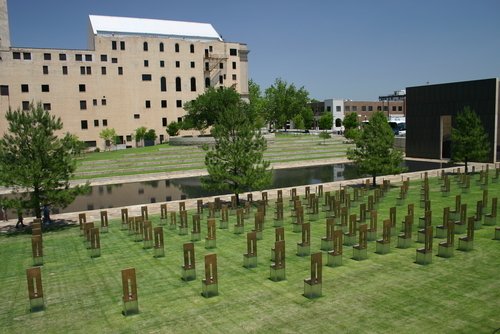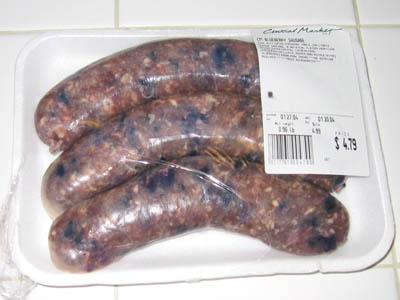I decided to take a break from my rundowns of past marathons. With
the Paralympics starting this week in London, the story of a young woman who is
far more awesome and inspiring than I am seemed like a good choice. Of course, you still have to suffer through my own ramblings before you get to her story.
Recaps of Mobile,
Nashville, Deadwood and Missoula will be coming in the next few weeks.
--------------------------------------
 |
Front row, center seems like the perfect spot for
a mediocre runner/future captain of the "C" Team.
The number of people in this picture that mopped up
the track with me is far larger than those that I beat. |
During my high school cross country season in 1991, I didn’t
feel quite right. My left leg throbbed, just below the knee, for several days
in a row. My coach, Karl Englund, looked at me and said, “Kennedy, is it pain
or is it an injury?”
I looked back at him with a quizzical look. He explained,
“Pain is something you can run through without making it worse. An injury is
something that can get worse if you try to keep going.”
I admitted that I had no idea, but I knew it didn’t feel
normal. Finally, a few days before my 16th birthday, I went to the
doctor’s office for x-rays. Dr. Jon Browne, one of the best sports doctors in
the nation and a close friend of our family, came back in the room carrying the
x-rays.
“Here’s the deal, Mike,” Dr. Browne said. “You have a benign
tumor in your left tibia.”
For the next 27 minutes – it was probably 2.7 seconds – I
desperately tried to remember whether “benign” meant cancerous or not. When
you’re in a situation like that, things don’t make sense. At least they didn’t
for me.
“It’s a strange one,” Dr. Browne continued. “Usually, a
tumor is a growth, but yours is more like a hole, high in your shin bone. Take
a look at the x-ray. Your shin is being held together by less than a quarter of
an inch of bone. You could have shattered it by just walking down the street. I
don’t know how it stayed in one piece while you were running.”
A week later, I was riding in the backseat to Omaha, and my
parents talking in the front seat. I remember staying quiet. Dr. Browne was
pretty certain it was not cancerous, but we decided we needed a second opinion,
and the best bone doctor in the region was in Nebraska.
The doctor confirmed Dr. Browne’s diagnosis after what
seemed like the longest day of all time, getting test after test after CAT scan
after MRI in the hospital. During the ride home, my mom tried to talk to me,
but I remember asking if we could just turn on the World Series. The Twins were
taking on the Braves in Game 3, and I wanted to stop thinking for a while.
My emotions were mixed. I was happy that it wasn’t cancer,
but at the same time I knew I was going to go through a fairly significant
recovery period.
But I was lucky. The doctors told me that I needed to stay
off it for a few weeks. Ultimately the bone would fill in on its own. My dad
was a surgeon for more than 30 years, and he’s still baffled by the thought
that it could heal itself.
It was a low point in my life, but I rarely think about it.
Honestly, it wasn’t that bad. But when you hear “tumor,” especially when you’re
a naïve teenager, it seems terrible. I think deep down, I try to put it out of
my mind and just forget about it.
Sometimes, though, the memory hits me like a ton of bricks.
--------------------------------------
On May 19, 1999, Lacey went to the doctor, just like I did.
And, just like I did, she had a tumor in her tibia, just below the knee with
concern that it might be in her knee. But, while my doctor said the word
“benign,” Lacey’s doctor diagnosed her with a soft tissue cancer called
synovial sarcoma.
“It’s a super rare form of cancer, and there’s not really a
survival rate,” Lacey told me, flashing me a smile.
After four months of chemotherapy, the doctors called Lacey
and her parents into an office and told them that the only chance for survival
was to amputate the leg above the knee.
Lacey looked at her parents and stoically said, “Let’s do
it.”
She was nine years old.
I don’t know Lacey very well, but I’ve always enjoyed
talking to her. Her love of life is contagious. She never tried to hide her
leg. While cheering during DU basketball games, she even put bumper stickers on
her prosthetic, drawing attention to the leg and the causes she believed in.
Of all the many things that Lacey does well, her courage,
confidence and belief in herself and her abilities are at the top of the list.
People should not even think about feeling sorry for her.
There’s no reason to.
“People think it’s funny that I joke about it, but I have
amazing parking. I don’t have to pay for that meter out there. Are you kidding
me?” Lacey told me, beaming with a mischievous yet genuine smile. “I’ve met
incredible people, and it’s made me enjoy life so much more.”
Lacey was always active. She was a gymnast before the
amputation, and she wasn’t about to stop because of it. She was a high school
cheerleader, and when she went to DU, she went out for the team, knowing she’d
make it. Why wouldn’t she? She was damn good at it. Her high school team
competed nationally, and Lacey was a big part of that success. She had all the
confidence she needed – and deserved
 |
(Photo by Rich Clarkson
& Associates) |
|
The summer before she graduated from DU, Lacey was sitting
around after a Labor Day party, having a drink with her dad, T.J. Back in the
day, T.J. went to the Olympic trials for pole vaulting, and he became a well
respected pole vaulting coach over the next few decades, including a few stints
at the Olympics with “obscure countries,” according to Lacey.
T.J. looked at his daughter and said something like, “You
did well in cheerleading, but you know you could never become a pole vaulter.
You don’t have the speed.”
Make no mistake. Lacey’s dad knew about his daughter’s
competitiveness, but he has never given Lacey an out just because she was
working with a different kind of leg.
“Please. I was a gymnast. I can do anything I want,” Lacey
told him. “Who needs speed when you have strength?”
T.J.’s friend and former Northern Colorado coach Mike
Mattivi was at the table with them. “I’ll coach you,” Mike told her with a
shrug. “Just show up on the track, and we’ll figure it out.”
They had to figure it out because no above-knee amputee was
known to have done it. The Paralympics don’t offer the event. Do a search on
Google. What you’ll find are reasons why it can’t happen.
Guess what. Lacey didn’t bother checking Google.
Oh, and you know those technologically advanced prosthetics
that you saw Oscar Pistorius courageously use in the Olympic 400 meters?
 |
Lacey is hoping the Paralympics
add pole vaulting. |
Lacey used one of her old legs that was designed to look
natural. Because she didn’t have a racing leg and didn’t want to damager her
good one.
“There are a couple of things that are frowned upon and you
shouldn’t be doing in (the leg I used),” Lacey said. “Pole vaulting isn’t
mentioned, but it’s probably one of those things.”
She started clearing the bar. And that proved her dad wrong,
which was the point originally. But then she realized she was having fun. She
had cleared about 7.5 feet.
Lacey wanted to compete. Since there were no other amputee
competitors, Lacey started entering open master’s meets and competing against
able-bodied athletes. She held her own.
But Lacey wanted more. She was fitted for a running leg and
started training, running on the track and trying to gain speed and strength.
At first, she struggled just running for five minutes.
As she was doing her training sprints, she realized
something. She was pretty fast, too. In fact, she was pretty close to the
qualifying times for the Paralympics.
Lacey lined up at the Colorado State Championships on May
19, 2011, about eight months after she went to the track to begin her training.
She entered her first 100-meter race. It was 12 years to the day since doctors
amputated her right leg, an anniversary that used to leave Lacey stressed.
Lacey ignored the stress and ran a qualifying time for the
London Paralympics trials. In the first race she ever ran.
A year later, again on May 19, Lacey lined up against a
group that included Paralympic hopefuls and able-bodied runners.
 |
Lacey Henderson during her tenure as a DU cheerleader.
(Photo by Rich Clarkson & Associates) |
“I was running against a girl with two legs, and we were
right up beside each other. I was pushing, and I knew she was pushing, but I
was thinking, ‘I better beat you,’” Lacey said. “Right at the end, I did the
chest finish and I’d finally beat someone with two legs. It was a cool feeling
for sure. I’ve beaten a couple of other CP athletes, but that was like a real
person.”
That date – May 19 – used to cause anguish for Lacey, but
now she has run a couple of successful races the last two years, she now feels
what she calls “this sort of Zen” on that day.
Lacey was sick when she went to Trials this year, and she
knew her chances of making the team for London were slim. Officials ended up
averaging each runner’s best time from the previous two years. Lacey, of course,
had not even been running that long.
She was beaten out by the American record holder, Katy
Sullivan, but right after the race the coaches approached Lacey to discuss next
year’s World Championships in Lyon, France.
“It’s definitely not over for me,” Lacey wrote in an email
after the Trials. “I’m back to training and getting ready for next year’s
Nationals, where I can hopefully also be exhibiting the pole vault. Many more
exciting things to come!”
--------------------------------------
Twenty years ago, I considered myself lucky. I limped away
from a doctor’s office with nothing lost but a few months of running around
being an irresponsible high school kid.
Had things have gone a different way, I wish I was confident
that I would have been even half as positive as Lacey Henderson.
I would like to think that at some point I would have
rebounded and made the most of it. Lacey, on the other hand, went well beyond
that.
While watching Oscar Pistorius make the semifinals of the
Olympic 400 meters, Lacey summed up her attitude and her life in a Tweet
(@lacesyourfriend):
“The human spirit is truly capable of extraordinary things.
Couldn't be more proud of
@OscarPistorius. Losing my leg was the best blessing.”




























